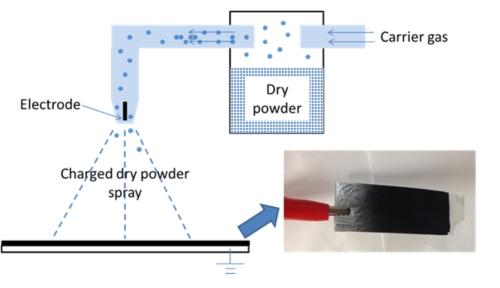Developing Additive Manufactured Battery Electrodes
In today’s electronic market, the lithium-ion batteries market is currently valued at over $12 billion dollars and is predicted to increase to over $50 billion by 2020. Lithium-ion batteries are used in everything from smart phones to electric cars. To make the lithium-ion batteries, many steps are conducted, including the use of a solvent. To reduce manufacturing time and costs, a new technology at Worcester Polytechnic Institute (WPI) has been developed that eliminates the need to use an expensive solvent. Typically, the use of the solvent is followed by a slurry drying process. Eliminating the solvent results in no need for the slurry drying process and all equipment related to the process. In this new lithium-ion battery process, an additive manufactured process is used to coat the electrode.
In the figure above, the carrier gas enters a chamber interacts with the dry powder that is then moved to coat the electrode. The electrode coated can range from small to large plates.
This invention’s feature of no solvent usage results in higher energy cells for the batteries and creates lighter batteries. The focus of this invention is for lithium-ion batteries and has the potential to be used for all other types of batteries.

Key Features/Benefits
- New method for electrode coating on lithium-ion batteries
- Removes need of expensive solvent
- Creates lighter and more energy efficient batteries
- High demand for lithium-ion batteries ranging in sizes for items form cell phones to cars
- 3-D electrode printing